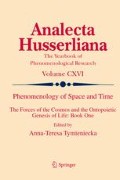Abstract
The paper focuses upon creativity as the essential trait of philosophically understood humor and the comic.
Arthur Koestler’s bisociation theory is referred to, which interprets humor as one of the forms of human creative activity, consisting in the ability to perceive phenomena simultaneously in traditionally separate and incompatible planes of reference. True humor escapes routine, presenting familiar situations from multiple angles and thus in a new light. The akin potential can stimulate creativity also in other spheres of human activity, including art or science.
Anna-Teresa Tymieniecka’s phenomenology of the human creative act, which is shown to possess its universal cosmic foundation is also applied to analyze humor as one of the manifestations of the sources of life.
In the present author’s opinion, humor can be recognized as a symbolic – though perverse – expression of the creative potential inherent in human spirit as well as in life itself.
Access this chapter
Tax calculation will be finalised at checkout
Purchases are for personal use only
Notes
- 1.
Cf. Mircea Eliade, The Sacred and The Profane: The Nature of Religion, trans. Willard R. Trask (New York: Harper Torchbooks, 1961); C. G. Jung, The Archetypes of the Collective Unconscious, in Collected Works of C. G. Jung (Princeton: Princeton University Press, 1968), Vol. 9, Part 1.
- 2.
Maurice Charney, “Comic Creativity in Plays, Films, and Jokes”, in Handbook of Humor Research, ed. Paul E. Mcghee and Jeffrey H. Goldstein (New York, Berlin, Heidelberg, Tokyo: Springer-Verlag, 1983), p. 34.
- 3.
Arthur Koestler, The Act of Creation (New York: The Macmillan Company, 1967).
- 4.
Cf. Don L.F. Nilsen, Humor—Other Views http://science.jrank.org/pages/9718/Humor-Other-Views.html (access: 10/15/2012).
- 5.
Immanuel Kant, Anthropology from a Pragmatic Point of View (Cambridge: Cambridge University Press, 2006).
- 6.
Cf. Sigmund Freud, The Joke and Its Relation to the Unconscious (New York: Penguin Classics, 2002).
- 7.
Cf. John Morreall, “Introduction”, in The Philosophy of Laughter and Humor, John Morreal, ed. (Albany, NY: State University of New York Press, 1987), p. 6.
- 8.
Marcella Tarozzi Goldsmith, Nonrepresentational Forms of the Comic. Humor, Irony, Jokes (New York: P. Lang, 1991), p. 30.
- 9.
Cf. Helmut Plessner, Laughing and Crying: A Study of the Limits of Human Behavior, trans. J. S. Churchill and Marjorie Grene (Evanston, IL: Nortwestern University Press, 1970).
- 10.
Arthur Koestler, op. cit., p. 56.
- 11.
Ibidem, p. 64.
- 12.
Cf. Sigmund Freud, The Joke and Its Relation to the Unconscious, op. cit.
- 13.
Lawrence Kimmel, “Philosophy, Literature, and Laughter. Notes on an Ontology of the Moment”, in Enjoyment: From Laughter to Delight in Philosophy, Literature, the Fine Arts, and Aesthetics, ed. Anna-Teresa Tymieniecka (Dirdrecht/Boston/London: Kluwer Academic Publishers, 1998), pp. 176–177.
- 14.
Anna-Teresa Tymieniecka, “Introduction”, in Enjoyment: From Laughter to Delight in Philosophy, Literature, the Fine Arts, and Aesthetics, op. cit., p. xi–xii.
- 15.
Ibidem.
- 16.
Marcella Tarozzi Goldsmith, “Nonrepresentative Forms of the Comic. Humor, Irony, Jokes”, in Enjoyment: From Laughter to Delight in Philosophy, Literature, the Fine Arts, and Aesthetics, op.cit., p. 29.
- 17.
Maurice Charney, “Comic Creativity in Plays, Films, and Jokes”, op. cit., p. 34.
- 18.
Ibidem.
- 19.
Roman Ingarden, The Literary Work of Art, trans. George G. Grabowicz (Evanston, Illinois: Northwestern University Press, 1973), § § 64, 68.
- 20.
Ibidem, § 64.
- 21.
Anna-Teresa Tymieniecka, “Introduction”, in Enjoyment: From Laughter to Delight in Philosophy, Literature, the Fine Arts, and Aesthetics, op. cit., p. xiii.
- 22.
Ibidem.
- 23.
As an example of such metaphysical quality Ingarden cites the grotesque. Cf. Roman Ingarden, The Literary Work of Art, op. cit., § 48.
- 24.
Lawrence Kimmel, “Philosophy, Literature, and Laughter. Notes on an Ontology of the Moment”, op. cit., p. 181.
Author information
Authors and Affiliations
Corresponding author
Editor information
Editors and Affiliations
Rights and permissions
Copyright information
© 2014 Springer International Publishing Switzerland
About this chapter
Cite this chapter
Malecka, A. (2014). The Creative Potential of Humor. In: Tymieniecka, AT. (eds) Phenomenology of Space and Time. Analecta Husserliana, vol 116. Springer, Cham. https://doi.org/10.1007/978-3-319-02015-0_19
Download citation
DOI: https://doi.org/10.1007/978-3-319-02015-0_19
Published:
Publisher Name: Springer, Cham
Print ISBN: 978-3-319-02014-3
Online ISBN: 978-3-319-02015-0
eBook Packages: Humanities, Social Sciences and LawPhilosophy and Religion (R0)

